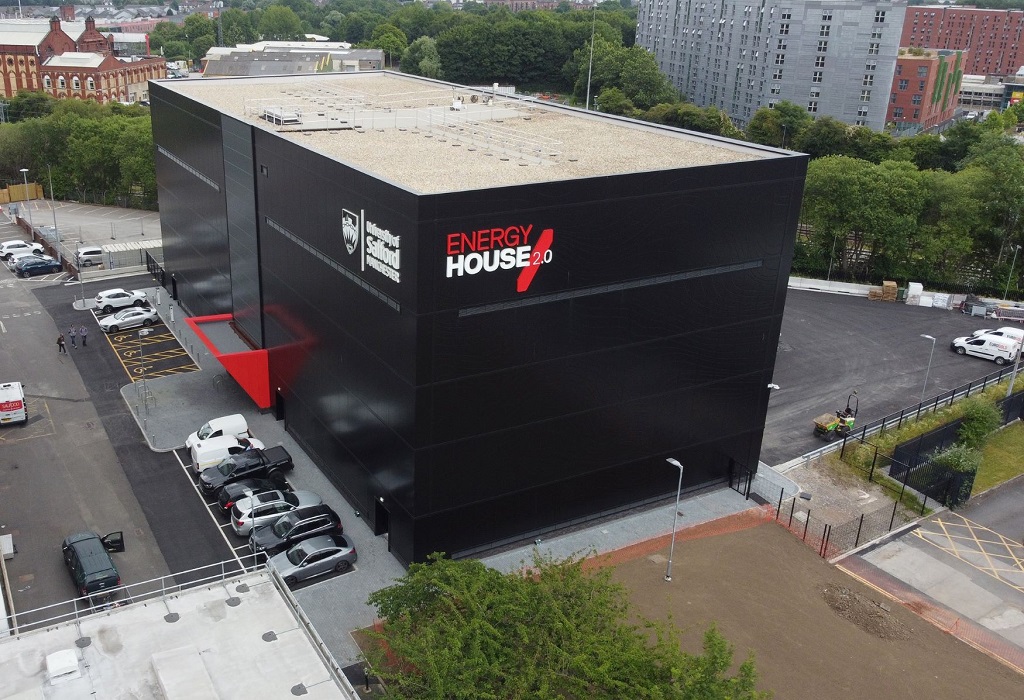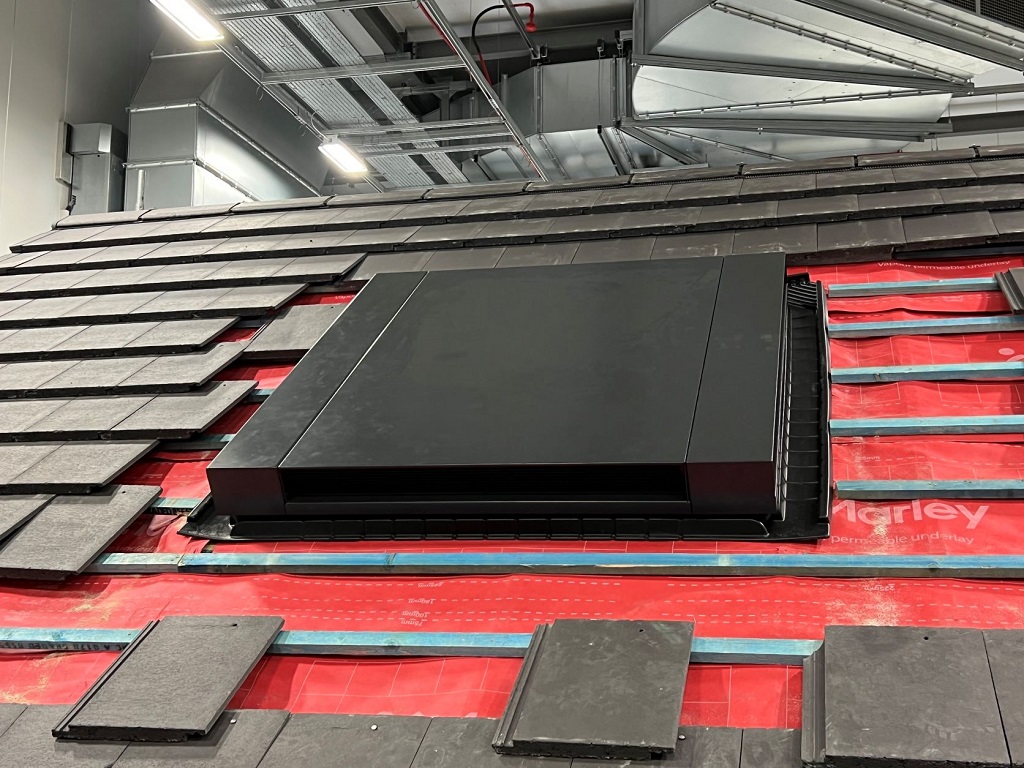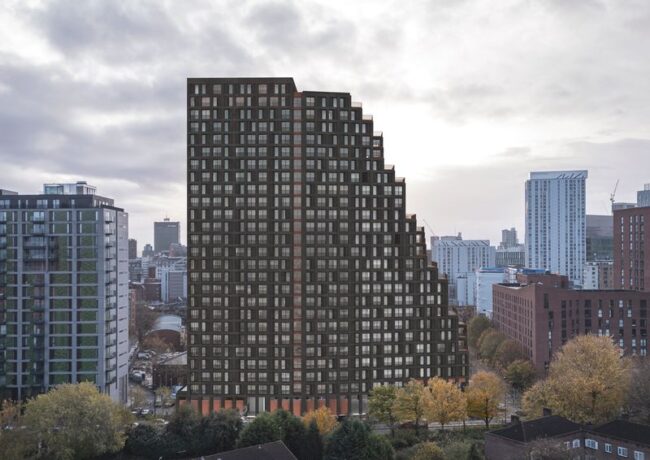Bellway trials roof-mounted air source heat pump
Claiming a UK first, the housebuilder has installed the low-carbon tech at the experimental eco-house The Future Home at the University of Salford.
The Future Home is being built by Bellway inside a climate-controlled chamber at the university as part of the £16m Energy House 2.0 research project, which is being part-funded by the European Regional Development Fund. The home will test low-carbon technologies and their impact on the cost of living.
Bellway has engineered the house to support the 200kg air source heat pump within the roof space. A second unit will be fitted to an external wall – generally, the location of air source pumps fitted to new housing under current practices – to enable comparisons to be drawn.
Air source heat pumps are being heavily promoted as natural gas boilers are phased out over the coming years. Part of the thinking behind moving them upwards is that at present they can dominate external elevations and take up space.
Jamie Bursnell, group technical and innovations manager for Bellway, said: “Installing an air source heat pump within a loft space is a bold move – one that no UK developer or retrofit project has previously attempted.
“During the research period, we will have people living within the home to test the performance of the heat pump during real-life use. If the unit in the loft performs well, it could create a new way for homeowners to reduce their carbon footprint without compromising on space or aesthetics.”
Bursnell continued: “It is well documented that air source heat pumps could increase running costs but so far there is little reliable data on their performance. We are looking to find the optimum settings to maximise effectiveness and minimise cost for our customers.”
The Future Home will also test underfloor and infrared heating, among other low-carbon innovations. These include mechanical ventilation, double versus triple glazing, battery storage for solar energy, and a shower that transfers heat from wastewater to warm the incoming mains supply. This reduces the energy demand from the shower.
Bursnell added: “The eyes of the new homes industry are focused firmly on this trial, but its impact could be much broader. The results could influence how householders make decisions as they replace their boilers in the coming years.”

Energy House 2.0 is located at Frederick Road. Credit: via Liberty PR
Bellway has worked closely with home heating manufacturer Worcester Bosch to prepare for the trial, with the company providing the Bosch 3400i Hydrotop Solution unit. Donaldsons Timber Systems redesigned the home’s timber frame to accommodate the unit.
Professor Will Swan, director of Energy House Labs at the university, said: “The growing challenges of climate change and the cost-of-living crisis mean we need to consider how we build and operate our homes. Energy House Labs’ mission is to work with industry and policymakers to provide evidence for what works in meeting these challenges.”
The development of Energy House 2.0 has taken six years of research and construction work to date, with the main part of the construction job completing this summer.
Located at the university’s Frederick Road campus, the project was led by Aecom and procured through Scape, with Perfect Circle providing a range of professional services during the process.
Bellway’s Future Home is now in its final stages, with an interior design team ready to make the house ready for occupation.





Looking forward with interest to the outcome of this. We are also involved innovations for sustainable solutions.
By Paul Bergin, VFES Ltd
The should be welcomed. The frustrating thing is that it wasn’t being done 10 years ago, or more, when we already knew about the existential climate crisis we were facing. Better late than never I suppose.
By Martin Cranmer
This is a really interesting scheme that could provide a practical solution to a big problem. Ground source heat pumps are quite large and unsightly and not everyone has room for one, but roof mounted air source heating could be a real game changer if it works.
By Jon P
This is where innovation should be at. Link this with PV as well and i reckon most houses could be nett zero pretty quickly. Orientation permitting 🙂
By bme
Servicing that will be a dream!
By Anonymous
Always nice to hear about innovation in the house building industry.
It would be lovely if the major builders could devote some resources to working out how to build larger living spaces or internal walls that don’t transmit noise or estates that include decent infrastructure.
By Cynical
Heat source pumps will definitely form the backbone of heating systems in the near future. Fossil fuel is on its way out thankfully, however, putting one in a roof space leaves me with a question, what about the noise? Heat pumps ain’t quiet that’s for sure.
By Bernard Fender
No doubt it will technically function. However, there is always the same hazard with these devices and it’s seemingly NEVER addressed with appropriate prominence and candidate solutions i.e NOISE and the use of SOUND ENCLOSURES. These exist and should definitely be part of any deployment that would otherwise lead to the noise of air cons everywhere in all our gardens and through our windows.
This is the elephant in the room that nobody wants to talk about and which will cause untold misery for so many who want to do the right thing or have their neighbours do the right thing. Enclosures are not even that expensive.
By John Ridge
Sound will likely be a problem in a roof setting, Heat pumps are known to be noisy and run for many hours per a 24 hour day. Add to this vibration generated noise /disturbances. While damper type fixing might mittigate some of the vibration it will likley not eliminate it. Add to this, most bedrooms are located on top floors, you have a perfect opportunity for disturbed sleep.
Maintenance of unit, how is that resolved, seems that health and safety risks have just gone through the roof!
By AJ
What is the point of a roof ashp which is more expensive to run than gas when we have infrared panels one per room which has no installation problems and is the cheapest product and heat available? It makes absolutely no sense.
By David Cooper
@ David Cooper you’ll be pleased to know that infrared panels are also being tested at Energy House 2.0 – it would be great if we can get dry electric heating to perform well enough without expensive plumbed-in wet heating. Still need hot water for washing and ASHPs currently look like our best option for this.
We CANNOT keep burning gas and other fossil fuels – in homes, in cars, or for power generation. The planet can’t take it.
By W